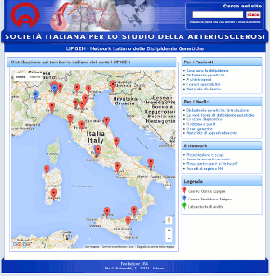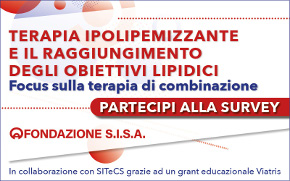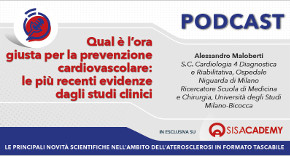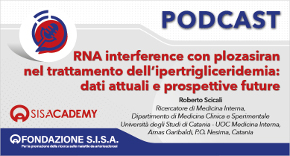 Rivista in lingua italiana
Rivista in lingua italiana
riservata ai Soci SISA
Ultimo numero:
Anno 16 • N.1/2025
Abstract
Ezetimibe Added to Statin Therapy after Acute Coronary Syndromes
Cannon CP, Blazing MA, Giugliano RP, McCagg A, White JA, Theroux P, Darius H, Lewis BS, Ophuis TO, Jukema JW, De Ferrari GM, Ruzyllo W, De Lucca P, KyungAh Im, Bohula EA, Phil D, Reist C, Wiviott SD, Tershakovec AM, Musliner TA, Braunwald E, Califf RM, for the IMPROVE-IT Investigators
New Engl J of Med. 2015; [Epub June 3], DOI: 10.1056/NEJMoa1410489
BACKGROUND Statin therapy reduces low-density lipoprotein (LDL) cholesterol levels and the risk of cardiovascular events, but whether the addition of ezetimibe, a nonstatin drug that reduces intestinal cholesterol absorption, can reduce the rate of cardiovascular events further is not known.
METHODS We conducted a double-blind, randomized trial involving 18,144 patients who had been hospitalized for an acute coronary syndrome within the preceding 10 days and had LDL cholesterol levels of 50 to 100 mg per deciliter (1.3 to 2.6 mmol per liter) if they were receiving lipid-lowering therapy or 50 to 125 mg per deciliter (1.3 to 3.2 mmol per liter) if they were not receiving lipid-lowering therapy. The combination of simvastatin (40 mg) and ezetimibe (10 mg) (simvastatin-ezetimibe) was compared with simvastatin (40 mg) and placebo (simvastatin monotherapy). The primary end point was a composite of cardiovascular death, nonfatal myocardial infarction, unstable angina requiring rehospitalization, coronary revascularization (=30 days after randomization), or nonfatal stroke. The median follow-up was 6 years.
RESULTS The median time-weighted average LDL cholesterol level during the study was 53.7 mg per deciliter (1.4 mmol per liter) in the simvastatin-ezetimibe group, as compared with 69.5 mg per deciliter (1.8 mmol per liter) in the simvastatin-monotherapy group (P<0.001). The Kaplan-Meier event rate for the primary end point at 7 years was 32.7% in the simvastatin-ezetimibe group, as compared with 34.7% in the simvastatin-monotherapy group (absolute risk difference, 2.0 percentage points; hazard ratio, 0.936; 95% confidence interval, 0.89 to 0.99; P=0.016). Rates of prespecified muscle, gallbladder, and hepatic adverse effects and cancer were similar in the two groups.
CONCLUSIONS When added to statin therapy, ezetimibe resulted in incremental lowering of LDL cholesterol levels and improved cardiovascular outcomes. Moreover, lowering LDL cholesterol to levels below previous targets provided additional benefit.
New Engl J of Med. 2015; [Epub June 3], DOI: 10.1056/NEJMoa1410489

Area Soci
Eventi
39° Congresso Nazionale
 39° Congresso Nazionale
39° Congresso NazionaleRoma, 23-25 novembre 2025
Save the date




 Spring Meeting Gruppi Giovani SID, SIGG, SIIA, SIMI, SIPREC, SISA
Spring Meeting Gruppi Giovani SID, SIGG, SIIA, SIMI, SIPREC, SISARimini, 6-8 aprile 2025
[continua a leggere]
 SISA LIPID ACADEMY - Corso avanzato di lipidologia clinica
SISA LIPID ACADEMY - Corso avanzato di lipidologia clinicaModena, 4-5 Luglio 2024
[continua a leggere]Giornale Italiano Arteriosclerosi
HoFH today
 Rivista Italiana della
Rivista Italiana della
Ipercolesterolemia
Familiare Omozigote
Anno 6 • N.1/2024
Rivista NMCD
Diateca
[continua a leggere]
[continua a leggere]
Newsletter
il vostro indirizzo di posta elettronica
Progetto LIPIGEN

Nuovo sito dedicato al Progetto LIPIGEN
Progetto LIPIGEN - Vecchio portale
E' necessario essere loggati come utente
Lipigen per poter accedere alla pagina
PROject Statin Intolerance SISA
PROSISA – PROject Statin Intolerance SISA
E' necessario essere loggati come utente
PROSISA per poter accedere alla pagina
GILA - Lipoprotein Aferesi
Gruppo Interdisciplinare Lipoprotein Aferesi
(Accesso Gruppo GILA-Lipoprotein Aferesi)
E' necessario essere loggati come utente del Gruppo GILA per poter accedere
Gruppo Interdisciplinare Lipoprotein Aferesi
(Documentazione ad accesso libero)
Pagina informativa per medici e pazienti










